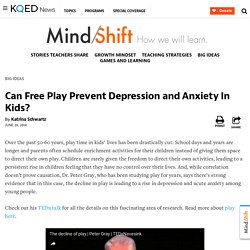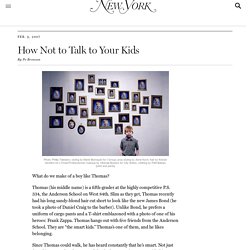

Juan Manuel
Learning Pit - Challenging Learning. Video_tcm4637467. Our cookie usage We use cookies to ensure that we give you the best experience on our website.

If you continue to use this website, we'll assume that you are happy to receive these cookies. Find out more about how we use cookies. Don't Expect Toddlers To Behave Consistently — They Literally Can't. Can Free Play Prevent Depression and Anxiety In Kids? Over the past 50-60 years, play time in kids’ lives has been drastically cut.

School days and years are longer and parents often schedule enrichment activities for their children instead of giving them space to direct their own play. Children are rarely given the freedom to direct their own activities, leading to a persistent rise in children feeling that they have no control over their lives. And, while correlation doesn’t prove causation, Dr. Which Early Childhood Experiences Shape Adult Life? By Maanvi Singh, NPR Most of us don’t remember our first two or three years of life — but our earliest experiences may stick with us for years and continue to influence us well into adulthood.

Just how they influence us and how much is a question that researchers are still trying to answer. Two studies look at how parents’ behavior in those first years affects life decades later, and how differences in children’s temperament play a role. The first study, published Thursday in Child Development, found that the type of emotional support that a child receives during their her first three and a half years has an effect on education, social life and romantic relationships even 20 or 30 years later. Articles 178053 archivo PDF libro desarrolloinfantil. Positive Learning Environment - Primary. EducatorsEn. NQS PLP E Newsletter No36. Key Person & Attachment.
The Key Person. How Are Happiness and Learning Connected? As teachers, we also know that when students' affective filters or defenses are sky high, fight or flight responses will be modus operandi. A room full of defensive behaviors (withdrawn, angry) is a sad, unproductive place to teach and learn. Now let's flip it and take a look at how much more we are able to learn when we are in harmony with the people and things in any given educational environment. Being in harmony means feeling safe, feeling valued and a necessary part a group, and in this case, a learning community. Hearts and Minds in Sync What does research show to be the opposite of the brain's fight or flight response?
Co-founder of the NeuroLeadership Institute Dr. 267671cb 0ec0 4039 b97b 7ac6ce6b9c10. Development Matters FINAL PRINT AMENDED. Whole Child Development Is Undervalued. The question is how to make such an approach both systemic and sustainable. Whole Person Socio-emotional, physical, creative, and cognitive capacities are deeply intertwined and equally important in ensuring a child's wellbeing, learning, and growth.
Look Who's Talking! All About Child Language Development. What to consider when teaching English in large classes. How many students do you teach? Do you feel that your classes are too big? Author and education consultant Jason Anderson looks at the issues and offers some potential solutions. For many of us, our classes are larger than we would like them to be.
Practical tips. By Opal Dunn, educational consultant and author Introduction Young children learn English differently from most adults.

Most have an innate ability to pick up English while taking part in activities, by making sense of what they are doing and picking up the adult’s language that accompanies the activity. You can find out more in the British Council booklet ‘How young children learn English as another language’, also available on the parents pages of the LearnEnglish Kids website. School Radio - Nursery songs and rhymes.
Music and Movement Activities. 45+ Quick & Easy Kids Crafts that ANYONE Can Make! LearnEnglish Kids. LearnEnglish Kids. How to teach children English using illustrated storybooks. What makes illustrated storybooks such a good resource for teaching young learners of English? The British Council’s Gail Ellis, co-author of a storytelling handbook for primary English language teachers, explains. Listen to an interview with Gail in our podcast and register for her webinar taking place on Thursday, 2 October. Practical tips. Ey making mark matters76708 1. 5 Examples of Onomatopoeia. Onomatopoeia is a fun, linguistic tool used in literature, songs and advertisements.
Now that you've seen examples of the individual words, consider the following examples of onomatopoeia words in use. Take a look at the different onomatopoeia examples in Todd Rundgren's song, appropriately named Onomatopoeia. Ten ways to support your child’s English-learning at home. As the British Council opens a new Learning Time with Shaun & Timmy centre in Mexico for two- to six-year-olds, senior teacher Sarah Reid offers some useful tips for supporting your child’s learning at home. More and more parents want their children to learn English from a young age.
I often meet parents of children as young as two or three who say that proficiency in speaking English will help their child 'get ahead in a globalised world'. In other words, the sooner their children get started, the better. Selective mutism. Selective mutism is a severe anxiety disorder where a person is unable to speak in certain social situations, such as with classmates at school or to relatives they don't see very often.

It usually starts during childhood and, left untreated, can persist into adulthood. Assessment of Attention in Preschoolers. Schemas in Children’s Play - N a t u r e P l a y. Written by Clare CaroSchemas in Children’s Play are such an important concept when it comes to the development of our children that it’s worth taking the time to understand them so you can facilitate them when you see them.What are these schemas?

Well it’s really a fancy word for the urges that children have to do things like climb, throw things and hide in small places. They appear through play; perhaps it is the way they choose to do things, or what they desperately need to do out of the blue! Bringing It All TogetherAfter looking at each schema individually to get to grips with what each 'urge' is all about we may already be able to recognise some of the different ways they can appear in your child.Rotation, Trajectory, Enveloping, Orientation, Positioning, Connection, Enclosure/Container, Transporting and Transformation are urges that show in all children starting as early as their first birthday, some times before.How Can Knowing About These Urges Help Us? Does my toddler have a short attention span because she won’t sit still for a story?
A: It is perfectly normal for toddlers to not sit still very long—period.

Most don’t like to stay in one place for long now that they can explore in so many new ways—by running, jumping, and climbing. So, an adult’s idea of snuggling on the couch to hear a story may not be the same idea a toddler has for story-time. Talking with Babies and Toddlers June05. PowerfulInteractions. The power of positive relationships. How can parents and teachers best educate young children?
What principles can both teachers and parents bring to the education of very young children? Gillian Craig, who was part of the Learning Time with Shaun and Timmy writing team, explains. As teachers and parents, we follow certain principles in our roles. Often though, these principles overlap and all we need to do is recognise and reinforce these areas. Ask (the right) questions When my daughter came out of her class one day shortly after her course started, I asked her, 'What did you do in class today? '. The Power (and Peril) of Praising Your Kids. What do we make of a boy like Thomas?

Thomas (his middle name) is a fifth-grader at the highly competitive P.S. 334, the Anderson School on West 84th. Slim as they get, Thomas recently had his long sandy-blond hair cut short to look like the new James Bond (he took a photo of Daniel Craig to the barber). Unlike Bond, he prefers a uniform of cargo pants and a T-shirt emblazoned with a photo of one of his heroes: Frank Zappa. Thomas hangs out with five friends from the Anderson School. Play to Learn. Play to Learn: Discussion. The magic of child-directed play. The cognitive benefits of play: Effects on the learning brain. © 2008 - 2014, Gwen Dewar, Ph.D., all rights reserved Science supports many of our intuitions about the benefits of play.

Scientists Say Child's Play Helps Build A Better Brain : NPR Ed. Deion Jefferson, 10, and Samuel Jefferson, 7, take turns climbing and jumping off a stack of old tires at the Berkeley Adventure Playground in California.

Symbolic play and language development. 1. Introduction 1.1. Relationship between symbolic play and language Symbolic play, or pretend play, and language are known to be highly interrelated (DeLoache, 2002, McCune, 2010, Smith and Jones, 2011). Why play-based learning? (free article) - Early Childhood Australia.
Different types play. Importance of play for babies & children. How young children learn English through play. ZERO TO THREE. Password protected padlet. Teachers TV- How Do They Do It In Sweden? Heuristic play. Ideas, tips and resources for primary language teachers.
Deb Roy: The birth of a word. Let's Talk. The Woman Who Changed Her Brain: Barbara Arrowsmith-Young at TEDxToronto. How can I help my child to start talking? (Video)